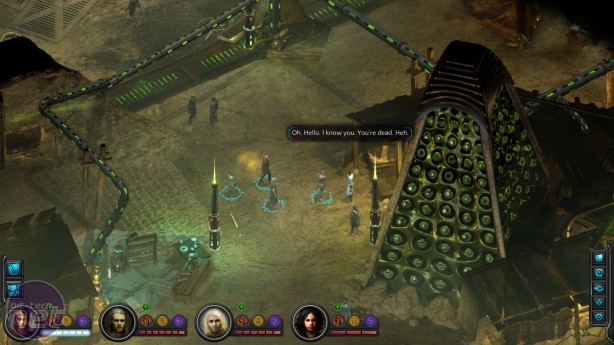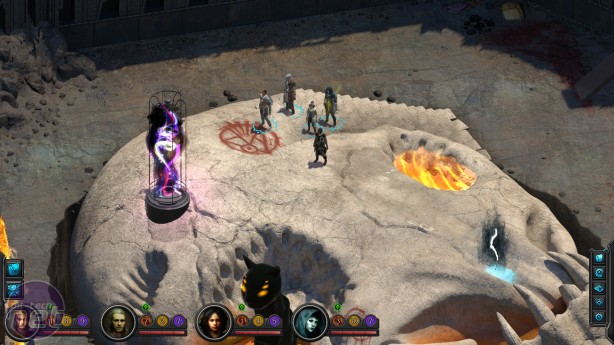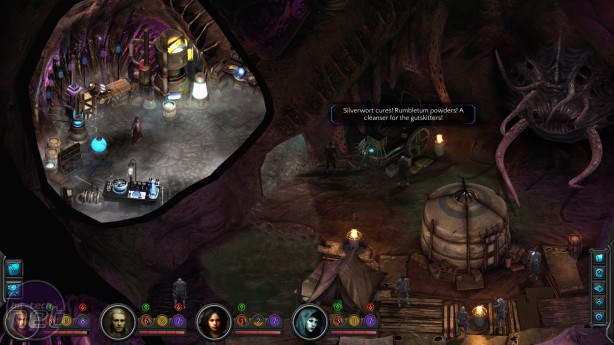
At a foundational level, Numenera is a familiar isometric RPG. Many of the aforementioned items fall into standard RPG categories, and the three classes you can play as roughly align to warrior, rogue, and mage. Yet whereas most RPGs are built around combat while allowing you to explore alternatives, Numenera takes pains to minimise combat, encouraging you instead to explore smarter, non-violent solutions.
Numenera’s dialogue and questing system is one of the best designed I’ve encountered. Basically, your character's abilities are split into three pools: might, speed and intellect. These pools are used to take actions both in combat and in dialogue. If you want to persuade someone into giving you an item, for example, you can spend a certain number of intellect points to increase the chance of success, whereas if you wanted to intimidate a group of hostile thugs and scare them out of fighting you, you would spend Might points to complete that action.
On top of this is a host of other potential influences on dialogue, such as Quick Fingers, which lets you snatch something from a cubbyhole or off another person, and Amenisis, your character’s unique ability to see and sometimes even alter the past. It isn’t all about finding a way to succeed in a particular action either. Wherever possible, InXile incorporates failure as part of the experience, leaving you other avenues to pursue or having it simply lead to a different resolution.
The same level of thoughtfulness is applied to the quests themselves. Each mission you encounter has a multitude of ways to complete it, and many interlink with one another so that completing one will hint at a solution to the next. An early example involves a strange creature in a district of Sagus Cliffs that is said to be terrorising the locals. You could simply kill the creature and put the people’s minds at rest. But if you’re perceptive, you can decipher its language and speak to it, opening up a bunch of other options. You could help it escape. You could try to reunite it with its subterranean tribe. You could kill it anyway and give its corpse to the Foundry’s robot foreman, who will fashion it into an item you need to complete another quest.
And this is one of the least interesting of Numenera’s many storylines (probably a 4/10 on the weirdness scale); just wait until you’re conversing with a man who has a portal to other dimensions in his chest (7/10) or investigating the mystery of the ghostly woman huddled in the corner of the psychics’ bar (10/10!!!). Even objects you pick up in the game world, referred to as artefacts and oddities, can reveal little mini-quests upon examination, where deciphering the runes carved on its surface or completing a short text adventure can yield a small reward.
Even when weapons are drawn against you, combat isn’t always the only solution. Indeed, combat scenarios are instead referred to as 'Crises', which usually include one or two alternatives to fighting. You might be able to talk your aggressors down or use the environment to entrap or disable your opponents. I could count the number of times I actively engaged in combat on one hand.
This is just as well, because combat is one of the few areas where Numenera really falls short. To begin with, it’s massively overcomplicated, with a huge number of variables to take into account. The combat’s overwrought nature also leads to it being slow and cumbersome, with fights often taking half an hour to resolve. This is partly because Numenera’s standard method of making combat challenging is to overwhelm you with opponents. Couple this with a loose movement system that often leads to characters getting stuck or not moving quite where you wanted, and frustration quickly mounts.
My other main complaint is that the introduction doesn’t do a great job of explaining character creation. Its idea is to build your character for you by asking a series of questions and assigning attributes according to your responses. But this led to me creating a character who was useless in combat without me realising he was useless in combat (this is unrelated to my criticism of the combat, by the way; I later improved all characters’ fighting abilities, and it remained a sluggish and clumsy experience). The tutorial doesn’t communicate how Numenera’s rules function effectively, so you end up trying to fathom it out while also taking in all the information about the strange world around you. And that is a little off-putting.
Still, once you’ve adjusted to how Numenera works, it's an absolutely captivating RPG, jam-packed with mysteries, superbly drawn characters, and a beautifully designed dialogue and interaction system that encourages you to think rather than fight your way out of a dilemma. It may not be Planescape 2, lacking the jet-black humour of Black Isle’s magnum opus, but it is a worthy successor, capturing its strange spirit brilliantly.
Numenera’s dialogue and questing system is one of the best designed I’ve encountered. Basically, your character's abilities are split into three pools: might, speed and intellect. These pools are used to take actions both in combat and in dialogue. If you want to persuade someone into giving you an item, for example, you can spend a certain number of intellect points to increase the chance of success, whereas if you wanted to intimidate a group of hostile thugs and scare them out of fighting you, you would spend Might points to complete that action.
On top of this is a host of other potential influences on dialogue, such as Quick Fingers, which lets you snatch something from a cubbyhole or off another person, and Amenisis, your character’s unique ability to see and sometimes even alter the past. It isn’t all about finding a way to succeed in a particular action either. Wherever possible, InXile incorporates failure as part of the experience, leaving you other avenues to pursue or having it simply lead to a different resolution.
The same level of thoughtfulness is applied to the quests themselves. Each mission you encounter has a multitude of ways to complete it, and many interlink with one another so that completing one will hint at a solution to the next. An early example involves a strange creature in a district of Sagus Cliffs that is said to be terrorising the locals. You could simply kill the creature and put the people’s minds at rest. But if you’re perceptive, you can decipher its language and speak to it, opening up a bunch of other options. You could help it escape. You could try to reunite it with its subterranean tribe. You could kill it anyway and give its corpse to the Foundry’s robot foreman, who will fashion it into an item you need to complete another quest.
And this is one of the least interesting of Numenera’s many storylines (probably a 4/10 on the weirdness scale); just wait until you’re conversing with a man who has a portal to other dimensions in his chest (7/10) or investigating the mystery of the ghostly woman huddled in the corner of the psychics’ bar (10/10!!!). Even objects you pick up in the game world, referred to as artefacts and oddities, can reveal little mini-quests upon examination, where deciphering the runes carved on its surface or completing a short text adventure can yield a small reward.
Even when weapons are drawn against you, combat isn’t always the only solution. Indeed, combat scenarios are instead referred to as 'Crises', which usually include one or two alternatives to fighting. You might be able to talk your aggressors down or use the environment to entrap or disable your opponents. I could count the number of times I actively engaged in combat on one hand.
This is just as well, because combat is one of the few areas where Numenera really falls short. To begin with, it’s massively overcomplicated, with a huge number of variables to take into account. The combat’s overwrought nature also leads to it being slow and cumbersome, with fights often taking half an hour to resolve. This is partly because Numenera’s standard method of making combat challenging is to overwhelm you with opponents. Couple this with a loose movement system that often leads to characters getting stuck or not moving quite where you wanted, and frustration quickly mounts.
My other main complaint is that the introduction doesn’t do a great job of explaining character creation. Its idea is to build your character for you by asking a series of questions and assigning attributes according to your responses. But this led to me creating a character who was useless in combat without me realising he was useless in combat (this is unrelated to my criticism of the combat, by the way; I later improved all characters’ fighting abilities, and it remained a sluggish and clumsy experience). The tutorial doesn’t communicate how Numenera’s rules function effectively, so you end up trying to fathom it out while also taking in all the information about the strange world around you. And that is a little off-putting.
Still, once you’ve adjusted to how Numenera works, it's an absolutely captivating RPG, jam-packed with mysteries, superbly drawn characters, and a beautifully designed dialogue and interaction system that encourages you to think rather than fight your way out of a dilemma. It may not be Planescape 2, lacking the jet-black humour of Black Isle’s magnum opus, but it is a worthy successor, capturing its strange spirit brilliantly.


MSI MPG Velox 100R Chassis Review
October 14 2021 | 15:04














Want to comment? Please log in.